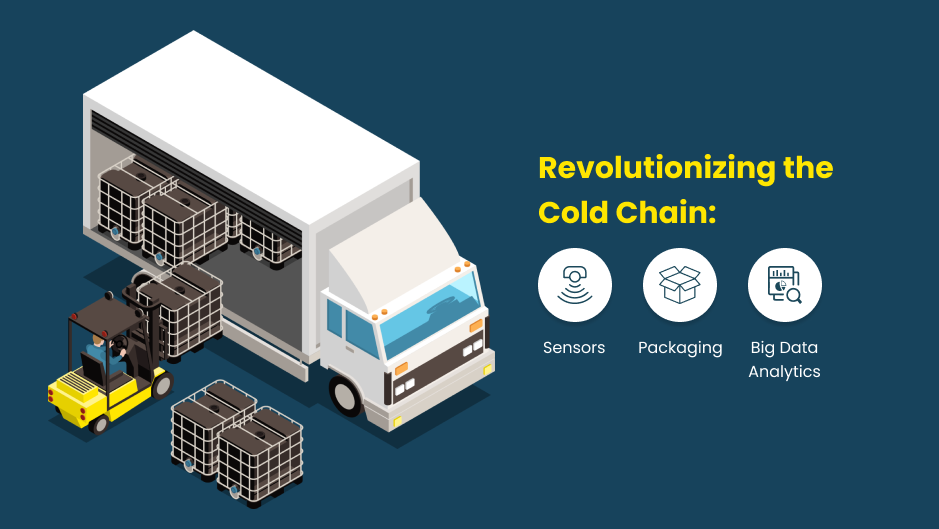Revolutionizing the Cold Chain: Sensors, Packaging, and Big Data Analytics
Introduction
The perishable goods industry faces significant challenges in maintaining the quality and safety of products during transportation and storage. Cold chain logistics plays a crucial role in preserving the integrity of temperature-sensitive items, from food and beverages to pharmaceuticals. In recent years, advances in cold chain sensors, packaging, and big data analytics have revolutionized the industry, leading to reduced waste and improved safety measures. This article delves into these innovations and their impact on the cold chain sector.

Cold Chain: Sensors, Packaging, and Big Data Analytics
Cold Chain Sensors: The Eyes and Ears of the Cold Chain
Temperature fluctuations can cause irreversible damage to perishable goods, emphasizing the need for accurate and reliable monitoring systems. Cold chain sensors have evolved to become more sophisticated, providing real-time data on temperature, humidity, and other environmental factors.
These sensors employ various technologies, such as radio frequency identification (RFID), Bluetooth, and the Internet of Things (IoT), to transmit information to a centralized system. This allows for continuous monitoring and immediate action when deviations from the desired temperature range occur. Furthermore, the integration of GPS technology enables precise tracking of shipments, ensuring transparency and accountability throughout the supply chain.
Smart Packaging: A Protective Shield for Perishable Goods
Innovative packaging solutions have emerged to provide added protection for temperature-sensitive products. Smart packaging materials are designed to insulate and regulate temperature, helping maintain the optimal environment for perishable goods. These materials include phase change materials (PCMs), vacuum insulated panels (VIPs), and temperature-buffering gels.
PCMs can absorb or release thermal energy to maintain a constant temperature within the package. VIPs offer high thermal resistance by reducing heat transfer through the packaging, while temperature-buffering gels provide a protective layer that prevents temperature fluctuations. These smart packaging technologies work together to minimize the impact of external temperature changes, ensuring the quality and safety of perishable items.
Big Data Analytics: Unlocking Insights for Improved Efficiency
The wealth of data generated by cold chain sensors and tracking systems has given rise to the use of big data analytics in the industry. Analyzing this data can reveal patterns and trends that enable businesses to optimize their cold chain operations. For example, data analysis can identify temperature variations during specific transportation routes or storage locations, allowing companies to address potential issues and implement corrective measures.
Moreover, big data analytics can help reduce waste by predicting the shelf life of perishable goods more accurately. By taking into account factors such as temperature, humidity, and time in transit, companies can better manage inventory and ensure that products reach consumers before their expiration date.
Machine learning algorithms can also be employed to analyze historical data and predict future trends, enabling businesses to make more informed decisions and improve their cold chain processes. Furthermore, the integration of big data analytics with other advanced technologies, such as artificial intelligence (AI) and blockchain, can enhance traceability and security throughout the supply chain.
The Future of Cold Chain Management: Emerging Technologies and Trends
As the cold chain industry embraces the benefits of sensors, smart packaging, and big data analytics, new technologies and trends are poised to further enhance the management of perishable goods. Here are some emerging developments that are expected to shape the future of cold chain logistics:
- Internet of Things (IoT) Integration: The integration of IoT technology in the cold chain will allow for even greater connectivity and data collection. IoT devices, such as sensors, GPS trackers, and other smart equipment, can communicate with each other and centralized systems to provide a comprehensive view of the cold chain. This increased connectivity willenable businesses to monitor and optimize their operations more effectively, resulting in improved efficiency and reduced waste.
- Blockchain Technology: Blockchain technology offers a secure and transparent method for tracking and verifying transactions within the supply chain. By utilizing blockchain, cold chain businesses can improve traceability and reduce the risk of tampering or fraud. This enhanced security can lead to increased consumer trust and confidence in the quality and safety of perishable goods.
- Autonomous Vehicles and Drones: The use of autonomous vehicles and drones in cold chain logistics has the potential to transform the transportation of perishable goods. These technologies can enable faster and more efficient deliveries, reducing the time that temperature-sensitive products spend in transit. Additionally, autonomous vehicles and drones can operate in challenging conditions or remote areas, expanding the reach of cold chain services to underserved regions.
- Advanced Energy Solutions: As the demand for cold chain services grows, so does the need for more sustainable and efficient energy solutions. Innovative technologies, such as solar-powered refrigeration units and advanced thermal energy storage systems, can help reduce the environmental impact of cold chain operations. These solutions can also lower energy costs, leading to more affordable and accessible cold chain services for businesses and consumers alike.
- Robotics and Automation: The implementation of robotics and automation in cold chain facilities can streamline processes and increase productivity. Robots can perform tasks such as loading and unloading shipments, sorting and packaging goods, and monitoring temperature and humidity levels. This can reduce the risk of human error and improve the overall efficiency of cold chain operations.
In conclusion, the future of cold chain management promises to be even more innovative and efficient, thanks to emerging technologies and trends. By staying at the forefront of these developments, businesses can ensure the continued safety and quality of perishable goods while minimizing waste and environmental impact. The integration of advanced technologies will undoubtedly lead to a more sustainable and robust cold chain, benefiting both the industry and consumers worldwide.
